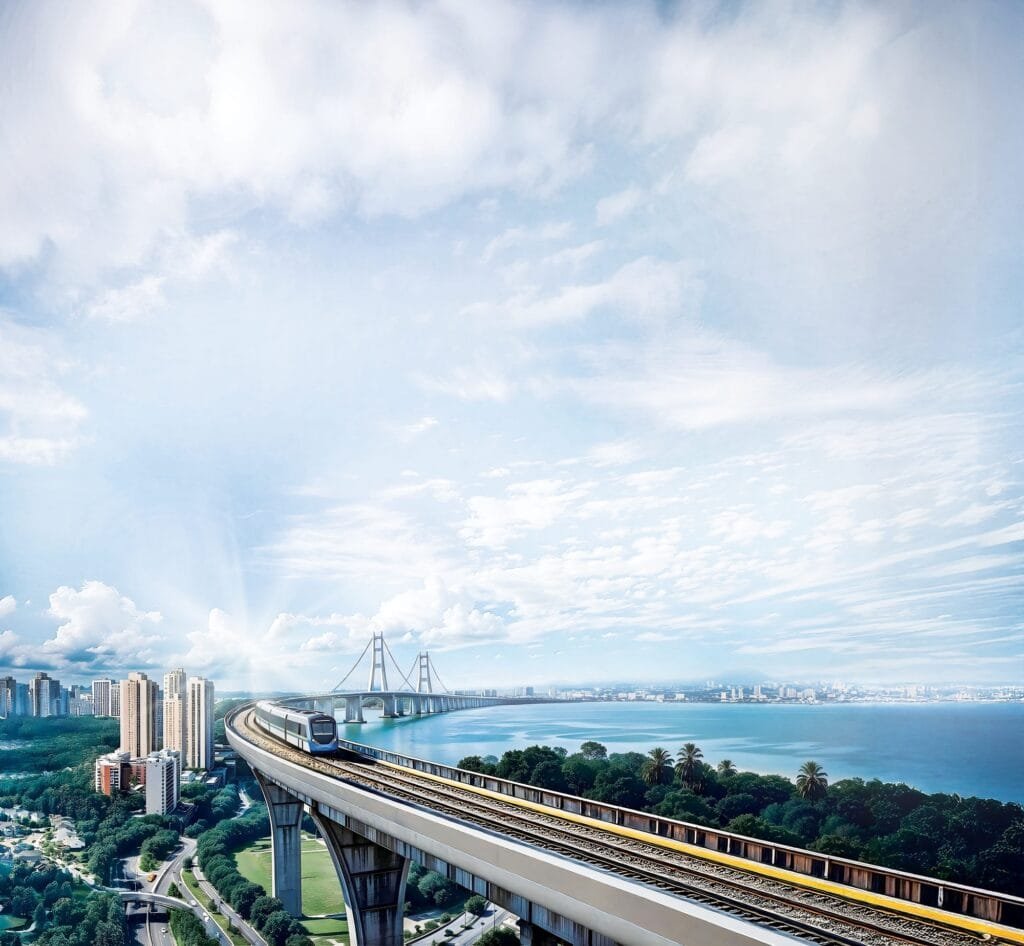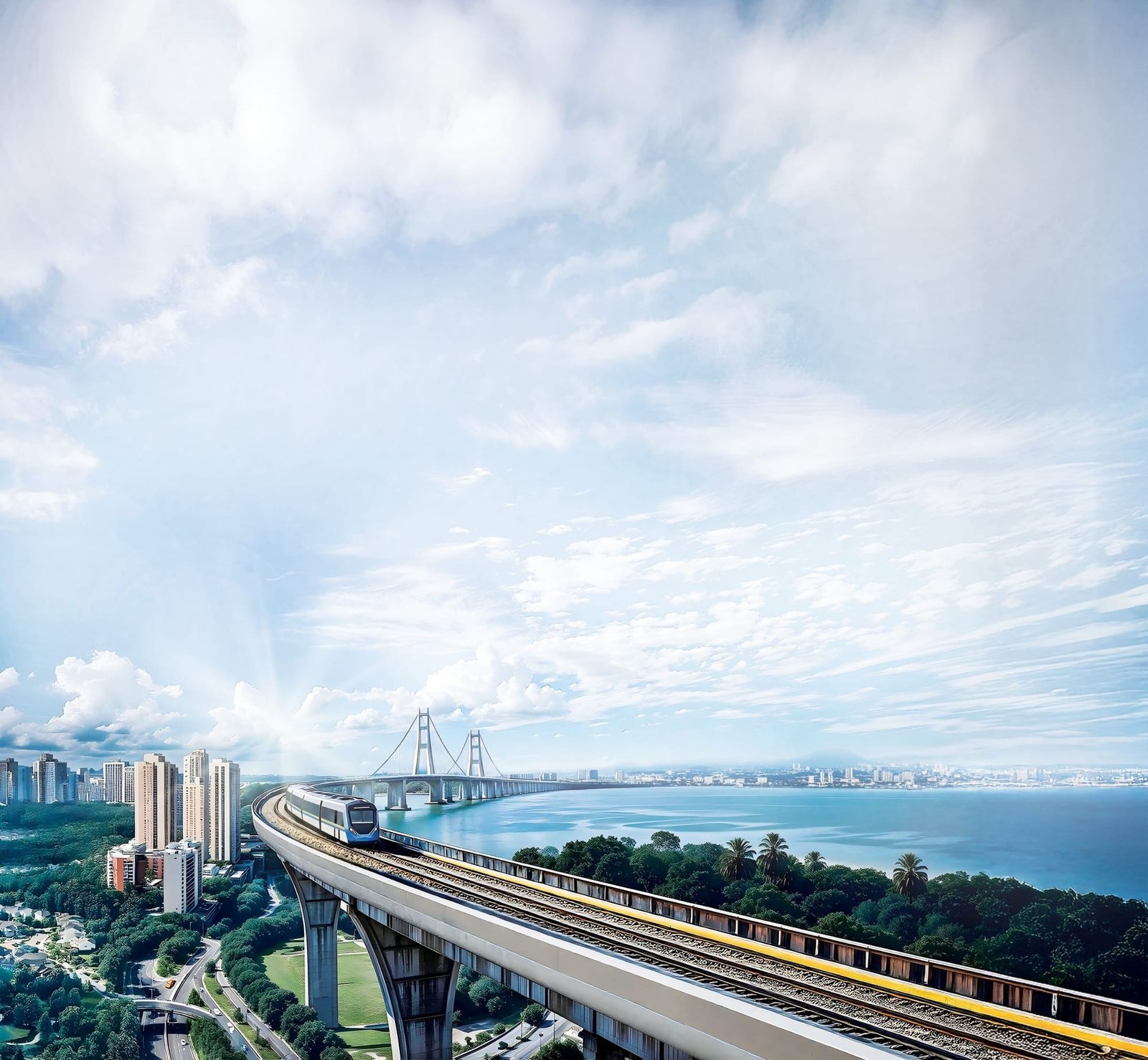Introduction
The Mutiara Line is set to revolutionize Penang’s public transportation network, offering a much-needed modern rail transit system to ease traffic congestion and improve connectivity. As part of the Penang Transport Master Plan (PTMP), this Light Rail Transit (LRT) project will enhance urban mobility, support economic growth, and promote sustainable travel. With an estimated daily ridership of 150,000 passengers, the Mutiara Line is expected to transform Penang into a more efficient, commuter-friendly city.

📌 Project Snapshot:
- Length: 29.9 km
- Stations: 23 stops across Penang
- Expected Completion: 2030
- Estimated Cost: RM 10 billion
- Operator: Penang Infrastructure Corporation (PIC)
1. Overview of the Mutiara Line Project
The Mutiara Line is Penang’s first Light Rail Transit (LRT) system, designed to address the state’s long-standing traffic congestion issues.
🚆 Key Features of the Mutiara Line:
- Elevated and ground-level tracks covering Penang Island and Mainland.
- Fully electric and eco-friendly trains reducing carbon emissions.
- Seamless integration with existing bus routes and ferry services.
- Smart ticketing system for cashless payments.
- Dedicated park-and-ride facilities at major stations.
📊 Why Penang Needs the Mutiara Line:
- 40% increase in vehicle traffic over the last decade.
- Over 500,000 daily commuters rely on inefficient road networks.
- Current public transport share is only 5%, far below Malaysia’s target of 40%.
- Growing tourism sector, with 7 million annual visitors requiring better transport infrastructure.
2. Key Stations & Route of the Mutiara Line
The 29.9 km LRT route will connect major commercial, residential, and industrial areas of Penang.
📍 Major Stations & Landmarks Along the Route:
- Komtar Central Station – Interchange hub linking buses, ferries, and transit networks.
- Bayan Lepas Industrial Zone – Serving over 300 multinational companies and thousands of workers.
- Penang International Airport (PIA) – Connecting travelers directly to the city center.
- Penang Sentral – Facilitating connections to KTM rail services for mainland commuters.
- Penang South Islands (PSI) – Future economic hub, supporting new housing and business zones.
🚇 Planned Connectivity Enhancements:
- Links to the Pan Island Expressway (PIE) for better road-rail integration.
- Feeder bus services to residential areas and tourism hotspots.
- Future expansion plans include connections to Butterworth and Seberang Perai.
📌 Commuter Benefits:
- Travel time from Komtar to the airport reduced from 60 to 30 minutes.
- Fare expected to be affordable, ranging between RM 2.50 – RM 5 per trip.
- Reduction in traffic congestion, improving air quality and fuel savings.
3. Economic & Social Benefits of the Mutiara Line
The LRT project is expected to boost Penang’s economy, real estate market, and tourism industry.
💰 Economic Impact:
- Expected to generate RM 20 billion in economic growth over 10 years.
- Creates 15,000 direct and indirect jobs during and after construction.
- Increases property values by 10-20% near transit stations.
🏙 Urban Development & Tourism Growth:
- Transit-Oriented Developments (TODs) will emerge around major stations.
- Encourages a walkable, pedestrian-friendly city.
- Provides tourists with easy access to heritage sites, beaches, and cultural attractions.
🚦 Traffic & Environmental Benefits:
- Expected to reduce 30,000 private cars from roads daily.
- Lowers carbon emissions by 15%, supporting Malaysia’s sustainability goals.
- Encourages the use of green mobility options such as bicycles and e-scooters.
4. Challenges & Implementation Roadblocks
Despite its benefits, the Mutiara Line project faces several hurdles that could delay construction and increase costs.
🚧 Major Challenges:
- Funding & Budget Allocation – Securing full financial backing from federal and state governments.
- Land Acquisition & Public Opposition – Concerns over displacement of businesses and residential areas.
- Environmental Impact – Balancing infrastructure needs with Penang’s natural landscape.
- Construction Disruptions – Managing traffic and business disruptions during the build phase.
- Regulatory Approvals – Ensuring all federal approvals and environmental clearances are obtained.
📌 Proposed Solutions:
- Public-Private Partnerships (PPP) to attract investors and reduce government burden.
- Transparent community engagement to address local concerns.
- Environmental safeguards to minimize ecological damage.
- Phase-by-phase construction to reduce disruption to daily life.
5. Future Outlook & Expansion Plans
The Mutiara Line is only the beginning of Penang’s long-term vision for an integrated public transit network.
🔮 Future Plans:
- Extensions to Seberang Perai for better mainland connectivity.
- Integration with high-speed rail (HSR) projects linking Kuala Lumpur and Thailand.
- Smart mobility solutions, including AI-powered traffic management and real-time transit tracking.
- Tourism and eco-friendly transit initiatives, such as electric shuttle buses for heritage zones.
📈 Projected Growth:
- By 2035, Penang’s public transport usage is expected to grow from 5% to 30%.
- Annual ridership expected to exceed 50 million passengers.
- Real estate and commercial investments around transit hubs could reach RM 50 billion.
Conclusion
The Mutiara Line is a game-changer for Penang’s public transport infrastructure, promising reduced congestion, better connectivity, and economic growth. Despite funding and implementation challenges, the project is poised to position Penang as a model smart city with sustainable urban mobility solutions.
📌 Key Takeaways:
✅ Penang’s first LRT system to ease congestion and improve connectivity.
✅ 23 stations covering major business and residential areas.
✅ RM 20 billion economic boost and 15,000 new jobs.
✅ Travel time reduced by 50%, with affordable fares.
✅ Expected completion by 2030, with future expansions planned.
💡 Do you think the Mutiara Line will transform Penang’s transport future? Share your thoughts!



